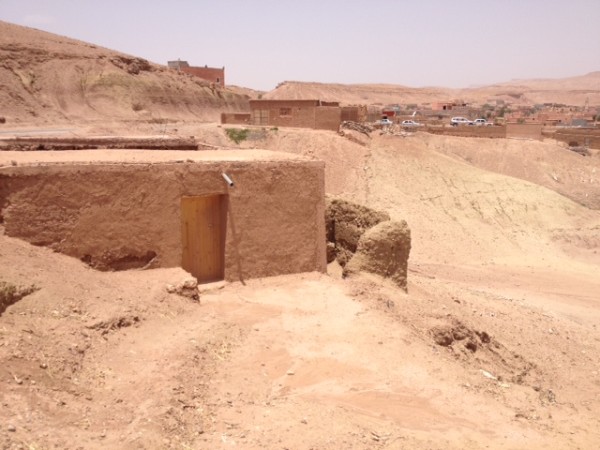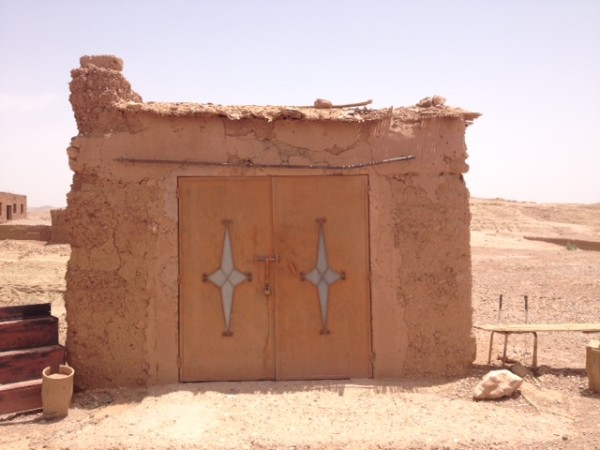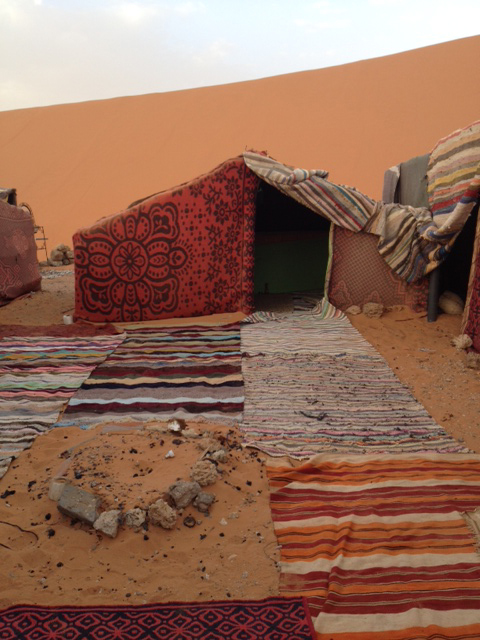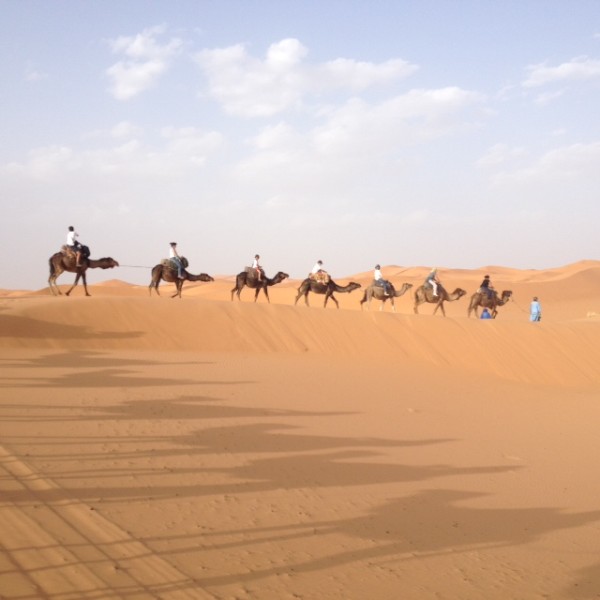After the beautiful country of Spain we headed down to the culturally fascinating country of Morocco. This small part of Africa is home a large coastline, parts of the Atlas mountains and touches on the nearly 3.7 million square mile Sahara desert. In these wild areas that seem to be on the very edge of existence are some interesting small, traditional homes.
Many people (specifically the Berber people of North Africa) in the Atlas mountains live and work as farmers raising goats, sheep, olives, wheat and fruit like dates, pomegranates and oranges. Because of the heat of the desert, homes have to keep both humans and animals cool and many of the homes you see are still built the traditional way. Bricks made with mud, sand and straw (sometimes animal dung) are laid out in the sun to dry. They are then stacked on top of a stone foundation and covered with mud plaster. Many of the homes don’t have windows, but instead have intricate metal grates for safety and airflow. Ceilings are made with bamboo stalks, the trunks of olive trees and covered with rocks and more mud plaster. Doors are actually made from the doors of shipping containers and then embellished with metal filigree and colorful paint.

Traditional Berber tents are located in the sand dunes of the Sahara. Unlike the Touareg nomads of West Africa, these tents stay in a location for years, even as the sandy landscape changes around them. Many small villages are built on harder rock that contains a small oasis. Wells are dug into the ground and water can be reached in about 15 feet. Tents and supplies are brought into the villages by camel or by dune buggy.
Berber rugs made of colorful wool yarn from both goat and sheep are used for the walls and floor while olive trunks are used as supports. Bamboo stalks are used for the roof. Tents are placed in a circle for protection from wind and sand and rugs are placed on the ground around a central fire pit.
You can take a camel trek out into the Sahara desert with several tour groups in the Marrakech area. The drive into the desert takes about two days and gives you an idea of how tough these people have to be to survive the extreme climates of this rugged country.
Photos by Christina Nellemann
By Christina Nellemann for the [Tiny House Blog]







Morocco…part of my bucket list. Beautiful!
It’s incredible how people live in some parts of the world. I have it so easy. Minimal dust. No sandstorms.
Come on….this is getting pretty far off now. Not what I expect to see on this site. Next, we’ll be seeing how to make a home from a box.
Lots of people need to know how to make a home from a box!
There’s quite a bit of inexpensive land available in desert areas in Texas, Arizona and New Mexico. My first thought when I saw this was that it is good information for people who have an interest in those land opportunities. I think this is interesting, worthwhile and timely information.
The photos show HOUSES that are TINY. Why does it surprise you that they would show up on a blog about tiny houses?
Well’ actually, there are many homeless people in our cities who can show you just how to do that 🙂
You know, I find hearing some history and culture of tinyhouses interesting.
Not far off at all. What’s the matter with with an article on how they construct homes in other cultures, using local or salvaged materials. And I’ll bet they’re not mortgaged either. Practical and informative, and something many in the west can learn from.
Very interesting- I wish we could have seen inside. I was amazed at the greenery growing over the doorway in the one photo and wondered if maybe it was a grapevine?
it was one of those plastic vines…from Ikea
Wendy, I too would love to see inside these fascinating little homes, and also a look at the metal grille work and how the doors are fashioned. The porch arbor with greenery was charming, but must also provide some cool shade. This is one of my favorite posts!
I was wondering, how well does that method of building work, in trying to stay cool in their high temps. Being deluged with health problems,is bad enough, but when your heart acts up because of the heat,it’s aggravating. 30 minutes in 85 degrees, lands me in the hospital. At 75 degrees, I can spend the whole day out, and suffer nothing more than tiredness, from over doing. Where I live now, I spend 99% of my time inside under the a/c. I would like to use it less, and I am looking for a way to build that would aid in that endeavor.
Hi Jonnie,
These houses work very well for staying cool at high temperatures. Much of Berberland in Morocco has a climate similar to southern Spain in Europe, and Texas, New Mexico, etc. in the USA. The older ones actually work much better than the newer Western style ones they are starting to build in Morocco.
The walls of these traditional Berber homes are fairly thick. The ones in this blog article are mostly earthen, much like adobe, but the Berbers also build stone ones. The walls could be up to a yard thick, and the window coverage is minimal which contributes a lot to cooling. The effect is much like the cooling one feels in a basement or cave. Very little air conditioning is ever needed in a traditional Moroccan home. However the new fashioned ones build mostly out of cement block usually do need AC.
The problem is that the newer generation in many parts of Morocco have a psychological association of traditional homes with poverty. Newer European style houses have a mental association with wealth and success, even if they don’t perform well in their climate.
Also the traditional homes need yearly maintenance. As long as one knows how to upkeep them they can, and do, last for centuries.
The general way they are built is like this:
The family collects stones for the foundation, and if they have the money employs a “Muallam” or Master builder. If not they make arrangements to do it themselves.
– They draw an outline of the house on the ground, clear away the outline of a trench, a metre/yard wide.
– They dig a trench down a metre/yard deep.
– They use the collected stone rubble and rocks to build two walls, one on both sides of the trench, – either mortared or dry-wall style. Each wall lining the trench is usually about a foot thick.
– They use small rocks to chink the spaces between big ones, everything has to fit tight. If it’s done dry-wall the method is identical to traditional dry-wall building done in Ireland and elsewhere in Eurasia. Just look at traditional stone mason dry-wall videos on YouTube to see how it’s done.
If it’s mortared you still do the same principles as dry-wall construction, except you use bedding mortar. You still chink the small interstices will smaller rock fragments and get everything to fit.
– Traditionally either lime mortar was used or clay mortar. Since it’s below grade if a family could afford it they would use lime. You burn ground or broken up Limestone, then resulting quicklime is carefully mixed with a clay and sand based mud, or it’s slaked and mixed as a putty with mud and sand. Over the last few decades Berbers would buy ready made lime if it was available, and then by the 1980s and 90s increasingly normal cement would be purchased. One thing that would also be done by poorer families is to boil ground up limestone and mud together, making a week lime based mortar.
– So now you have a yard-wide trench with foot thick walls on both sides, there is a cavity in the middle about a foot wide. This was filled up with small chucks of rocks and pebbles, usually mixed in clay slip mud. If a very strong wall is desired the pebbles would be mixed in lime mortar and poured in, or cement mortar.
– in modern houses concrete columns would be roughly poured with rebar in forms roughly crafted from wood. Then thick stone walls built up the same way as the foundation walls would be built infill style between the columns. Some Berbers still do it traditionally without concrete columns.
– The article mentions an aobe technique, which some Berbers do. They make adobe bricks in wooden molds clayish mud, sand and straw sometimes adding donkey dung. The walls are built up on top of the stone rubble trench foundation with adobe bricks, mortared with a clay slip type of mud.
In some parts of Berberland however they do rammed earth instead, making solid wooden slip forms, braced together, and pouring a dryer clay and sand and pebble mix, then pounding it with wooden tampers until it rings, it becomes almost hard as stone when it cures. You slip the forms up, detaching small putlogs that support it and moving it up the wall. This leaves holes which are filled in with clay.
– You make niches in the wall with a thick rock or wood beam as a lintel to store knickknacks, vases, food containers, family objects etc. Sometimes low sofa benches are build out partially from the thick wall into the floor space, and covered with cushions.
– The houses, depending on the region, may be plastered with a clay based plaster, with straw or dung mixed in to minimize cracking, or sometimes a lime based plaster.
– The floors are then sometimes dig down, since there’s metre/yard deep stone wall as a foundation they may manually dig out the floor for more headroom.
– The ceiling is framed with tree trunks, palm trunks, and thinner branches or saplings laid across. The article mentions ‘bamboo’, this is done or types of cane similar to bamboo. It’s usually laid in a decorative pattern across the means. A thick earth later or mortar layer is laid on top and tamped down. They sometimes put stones across.
And that’s how it’s done.
The Berbers sometimes may do different variations of this from Western Morocco all the way over to Tunisia, the Kabyles in Algeria do it a bit differently than the Rifis in Morocco who do it a bit different from the Sousis etc. But each ethnic group in North Africa does some basic variation.
Also more modern style homes may have this basic configuration but use cement blocks, purchased or locally molded, and sometimes even hollow structural clay tile style bricks used to build the walls. These definitely have concrete columns cast, and sometimes a concrete ring beam around the top that the roof framing sits on.
If you know what you are doing and carefully detail out the structure these are amazingly strong houses. However they do not perform well in earthquakes.
If you are not in a seismically active area then traditional stone houses or adobe mud brick houses can safely last a lifetime or two.
If you are in a seismically active area you’d want to read up on “confined masonry” which is a method of building traditional style homes like this that are more earthquake safe.
If you see ones in Morocco with thin cast concrete columns on the corners and around the window or door openings, they are actually doing a type of confined masonry. The practice is spreading worldwide but if it’s not done the right way the columns afford little real protection. There are free UN sponsored books on the web showing how to do confined masonry the right way.
Enjoyed the trip to the desert this morning. Made my dry land look lush. Just brought home chickens for the new coop. I hope for eggs, meat, and fertilizer for the garden.
Fascinating! Love seeing these various posts from interesting places in the world showing how others have adapted to their circumstances! I agree about being curious about the INSIDE… I was inside a tent in Turkey and it was exotic and comfortable. More of this type of thing please! Very fun and educational.
Thank you so much for posting this. I love seeing how people have been living the “tiny house” lifestyle forever all over the world.
I thought the same thing as Suzanne Bennet; How can this information be adapted to our areas?
I can so see creating sturdy tents such as those for living in many areas. I have often created a similar space when camping for long term here in Washington state where it gets fairly cold and definitely pouring rain in the summer. I will take a regular tent and cover it with wool army blankets, plus the blankets on the floor to insulate.
It keeps the inside completely dry and warm. I leave the front door uncovered and the window there open for fresh air. I am always the warmest, driest person in the event.
So if this works in Washington’s west coast, it will work in Arizona throughout the year.
I love learning about how people of different cultures live. I found this quite interesting. Thank you : )
Thank you, Christina. These small views of how people live with such meager means by our standards are inspiring. I’m concerned that that level of aridity is where “my” high desert is heading, and what lessons are there for us?
These photos remind me of life as a teenage living in Rabat; traveling around north Africa to these outer territories. Berber tribes lived across the street on a dusty arid piece of land, in colorful tents, beautifully woven rugs and tiny shanties. Life was filled with family, children playing marbles, kickball,…all sorts of games, which I heartily joined in with….and there were trees to climb, which gave me amply viewing vantage point. When a sand storm billowed through the area, all signs of life simply vanished until the sands settled in and around our dwellings. I loved it there and would love to go back at some point.
The Moroccan desert is magnificent a journey that is worth itself. One should go beyond the city of Marrakech and Fes to discover the Southern Morocco, different country, rugged yet so beautiful with ever changing scenery. Life there is tough, but people are friendly and love their simple lives.
Families bond and friendship means almost everything in this region.
While staying in the desert you can opt for Luxury tenting accommodation. These tents offer highest comfort with ensuite bathroom right in your tent. For the best location of the desert camp check the desertluxurycamp
In my dreams………. Where is your princess? Out picking daisies no doubt.
Happy trails,
SteveP
Even though they look terrible from outside, I’m pretty sure those houses are well isolated. People have lived in the deserts for many years and have perfectly adapted their homes to the surrounding harsh environment. I would definitely live in such a house, but only if it comes with a big harem 🙂
Thanks a lot for making this blog to share the world your experience and thank you so much for sharing with us your great desert trip in our lovely country 🙂
Great article about Morocco and lot of informations about Moroccan houses. thank yopu for sharing this article
Ohh what a wonderful article with so much infos and amazing pictures about Morococ, thumbs up and thanks for sharing this blog
Woow seems good I’m nomad man also I was living in the tented now I like in house with mud
I dream of owning a small kasbah in Morocco one day. I prefer someplace near water, like Tagazhout or Essaouira maybe. 🙂
Well definitely it goes into my bucket list after COVID 19.
I really like the berber culture in the south of morocco, thank you for sharing with us
Such an amazing blog, very interesting and informative… Morocco countryside is very unique and worth exploring. Thanks for the share!
Hi!.
Your website looks great, thank you so the information.